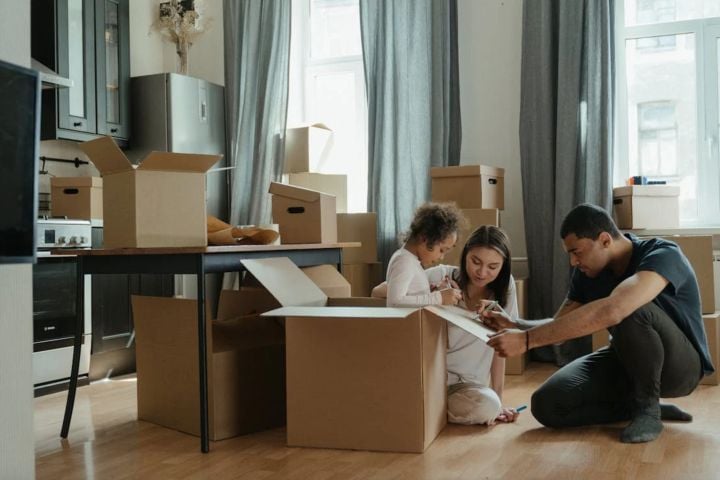Everyone focuses on “move day” and packing, forgetting how important it is to properly settle in. When the removal vans are gone, the neatly taped boxes are sitting in their correct rooms, and you’re spending the first night in your new home — what then?
In unfamiliar areas, quickly finding your feet is tricky. For professional help, Real Estate Movers is a long-distance moving company in Calgary with over a decade of experience in smooth relocations. Unlike local moving companies, there’s more pressure on long-distance movers to avoid delays. Nobody wants to be settling in without their prized possessions.
Are all your belongings safely arrived and stored? Here are the essential steps for settling in quickly.

Setting Up Your New Space
You’ve spent the last two months packing your life into dozens of boxes like a pro. Now, wave goodbye to restrictive storage and welcome back your possessions. These three steps will help to set up a new space.
1. Unpack with Purpose
People work on different timelines when settling into a new home, but be methodical to see the best results. For instance, choosing to unpack room-by-room and in order of necessity (your kitchen and bedroom probably shouldn’t wait until last).
Hopefully, you’ve already decluttered before you moved. If not, donate any unwanted goods to charity as you unpack.
2. Make Your Space Feel Like Home
A homely environment is important, especially after a long-distance move. Prioritize unpacking items of significant personal value or comfort. That could be your favorite duvet cover or a painting gifted by a loved one.
3. Get to Know Your Surroundings
Getting out into the neighborhood to build habits and connections is vital after a long-distance move. Find a special coffee spot, pick a grocery store, or stumble across the perfect jogging route.
Arranging Essential Utilities and Services
If you’ve been incredibly organized, it’s possible to have utilities up and running in a day or two. But did you know that the average wait for broadband in a new house is eight days?
Treat utilities and services as a matter of urgency, investing in a generous mobile data plan in the meantime. The quicker you’re connected, the more “at home” you’ll feel.
1. Setting Up Utility Connections
Before moving, inform your water and electric providers about the upcoming address change. However, registering for a water bill and chasing loose ends might leak into the settling-in period. Ideally, utilities will be finalized in the first few days.
2. Managing Internet, Phone, and TV Services
Your current provider may simply transfer your existing plan to your new address. But be aware that it can take a few days to set up. If in doubt, ring your provider and enquire about same or next-day installations.
Updating Your Address and Mail Management
Nobody likes constantly receiving the wrong mail. Double-checking mailing addresses is vital when settling into new homes.
1. Notify Key Organizations and Institutions
Consider notifying the following groups of your changed address:
- Your bank.
- Insurance companies (including driving insurance).
- Doctors and health professionals.
- Mobile phone and internet providers.
2. Organize Mail Forwarding Services
Canada Post has a paid Mail Forwarding service that redirects any parcels or letters still in transit.
Exploring Local Resources
Local resources are reassuring when settling into an unfamiliar area. It’s worth looking for the following:
- A gym or health center.
- A pharmacy.
- A library.
- A tech repair shop.
Managing Healthcare and Medical Records
Your medical records don’t automatically move with you. Contact your previous provider to request your personal documents and register with a new provider.
Getting Around: Vehicles and Transportation
Familiarize yourself with the public transportation network, driving your new neighborhood, and any unusual rules or legislation. Here’s what you could organize:
- Registering for any public transportation cards or discounts.
- Updating your driving license address.
- Finding your nearest gas station.
Enrolling in Schools and Educational Resources
Ideally, families or students would have already enrolled in local schools. But if not, there’s no time like the present.
Contact your local school board, and in the meantime, search for educational resources like libraries.
Staying Safe: Emergency Contacts and Information
In Canada, 911 is the standard number for emergency services. However, there might be different numbers to contact for local assistance in rural areas. Check and note any variations.
Touch base with friendly neighbors and new work colleagues. And list your personal emergency contact (like a partner or family member) where necessary.
In Conclusion
It’s not just long-distance movers that have a trickier task than local moving companies; it’s challenging for the homeowners, too. No matter how excited you are about the relocation, settling into a new home can be tough. Be kind to yourself and use proactive organization to create an easier transition.
We hope you found this blog post on Settling Your New Home after a Long-Distance Move, useful. Be sure to check out our post Tips on How to Move Out of State for more great tips!
Have Experience in the Moving Industry? Want an Additional Income Stream? Work With All Around Moving!
Partner with us, moving consultants, and we’ll help you profit. Do not hesitate to contact us by clicking the link below. We’ll help every step of the process. Click here to learn more.






